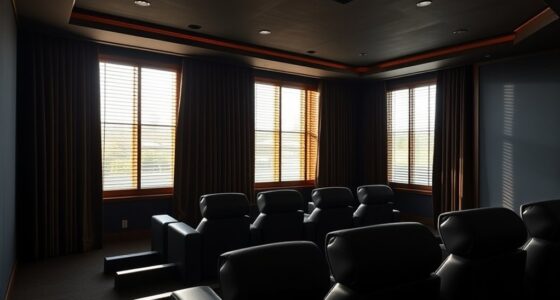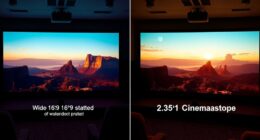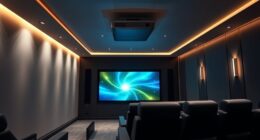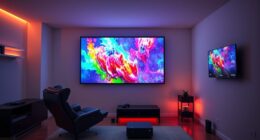Before you start designing your ambient lighting, it’s vital to understand some common myths and facts. Brightness isn’t always better, and the positioning of fixtures plays a key role in creating a comfortable, even glow. Warmer light feels cozy, but cooler tones can boost focus, depending on the space. Proper layering, placement, and control help you avoid glare and shadows, ensuring your space feels inviting. Keep exploring to discover how these insights can transform your lighting approach.
Key Takeaways
- Brighter lighting does not always create a more inviting or comfortable environment.
- Proper fixture placement and light layering enhance ambiance more effectively than simply increasing brightness.
- Warm light (2700K-3000K) is not always best for coziness; cooler light (above 4000K) can improve focus.
- Avoid fixed assumptions about color temperature; mood depends on context, task, and personal preference.
- Achieving balanced ambient light involves strategic placement, glare control, and combining different lighting layers.
Common Misconceptions About Brightness and Light Placement

Many people believe that brighter lights always create a more inviting space, but this isn’t necessarily true. Light intensity affects how comfortable a room feels, and more isn’t always better. Overly bright spaces can feel harsh or unwelcoming. Proper fixture positioning plays a vital role in achieving a balanced atmosphere. Instead of just increasing brightness, you should focus on placing fixtures strategically to distribute light evenly. For example, placing lights at different heights or angles can reduce glare and shadows. Remember, the goal isn’t just to make a room bright but to create a comfortable ambiance. Utilizing sound design techniques such as layering and spatial placement can also enhance the overall environment. Brightness combined with thoughtful fixture positioning will help you avoid common misconceptions and achieve an inviting, well-lit environment.
Debunking Myths Surrounding Color Temperature and Mood
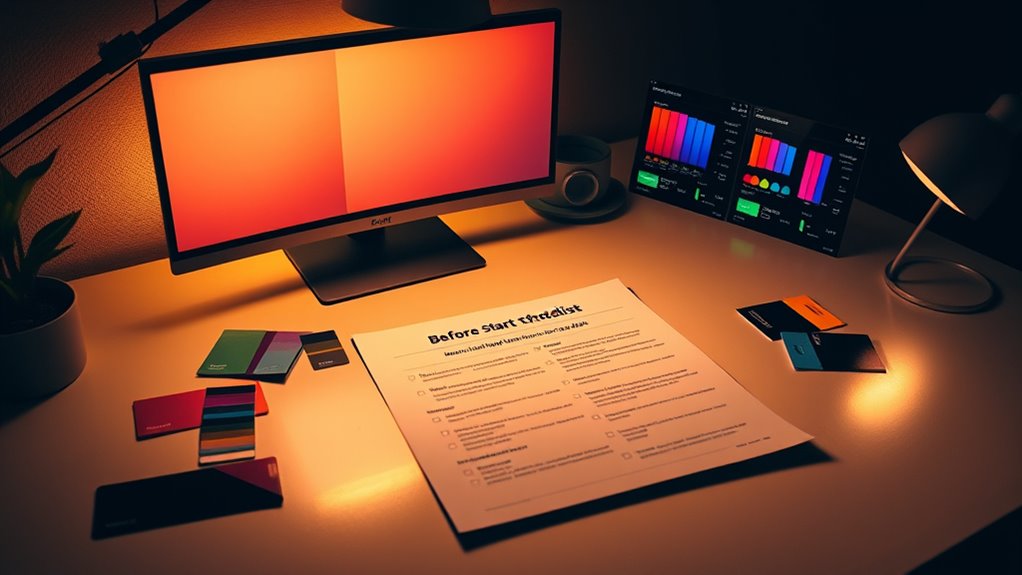
Have you ever assumed that warmer light always creates a cozy atmosphere while cooler light feels clinical? That’s a common myth about color temperature and mood perception. In reality, the impact of light on mood depends on context and individual preference, not just the Kelvin rating. Warm light (around 2700K to 3000K) can feel inviting, but in some settings, cooler light (above 4000K) may boost alertness and focus. Conversely, overly warm or cool lighting isn’t automatically ideal; it’s about matching the mood you want to create. Misunderstanding this can lead to ineffective lighting choices. Remember, the relationship between color temperature and mood perception isn’t fixed—it’s flexible and influenced by factors like space, task, and personal taste.
Essential Facts for Achieving a Balanced and Functional Ambient Light

What are the key elements to contemplate when creating a balanced and functional ambient light? First, proper lamp placement ensures even coverage without dark spots. Second, glare control is essential to prevent harsh reflections that cause discomfort. Third, consider light layering by combining ambient, task, and accent lighting for flexibility. Fourth, choose fixtures with diffusers or dimmers to adjust brightness and minimize direct glare. Fifth, incorporating rustic lighting fixtures can add character and complement farmhouse decor. These factors work together to create a comfortable environment. Guaranteeing lamps are positioned at appropriate heights and angles reduces harsh shadows. Managing glare through fixture design and placement enhances visual comfort. By focusing on lamp placement and glare control, you’ll achieve a well-balanced, functional ambient light that supports both mood and practicality.
Frequently Asked Questions
How Do I Choose the Best Ambient Light for Small Spaces?
To choose the best ambient light for small spaces, focus on color temperature and fixture placement. Opt for warm light around 2700K to create a cozy atmosphere, or cooler light for a more energetic vibe. Place fixtures strategically to avoid clutter and shadows, using ceiling or wall-mounted options to maximize space. Keep the light level balanced to enhance the room’s openness and comfort, making your small space feel inviting.
What Are the Safety Considerations When Installing Ambient Lighting?
Think of installing ambient lighting as weaving a safe, glowing tapestry. You must place light fixtures carefully, avoiding wires that tangle like wild vines. Check that wiring safety is exceptional, with proper insulation and secure connections, preventing sparks from dancing dangerously. Make sure fixtures are rated for your space and avoid overloading circuits. By minding light fixture placement and wiring safety, you create a luminous sanctuary that’s both beautiful and secure.
Can Ambient Lighting Reduce Energy Consumption Effectively?
Yes, ambient lighting can decrease energy consumption effectively when you choose energy-efficient fixtures and control systems. By optimizing lighting efficiency, you minimize unnecessary power use while maintaining a comfortable environment. Using dimmers, timers, or motion sensors helps you customize lighting levels, saving energy without sacrificing ambiance. This strategic approach ensures you get the desired atmosphere while lowering your overall energy costs, making ambient lighting a smart, eco-friendly choice.
How Does Ambient Light Affect Sleep Quality and Circadian Rhythms?
Ambient light can negatively affect your sleep quality and disrupt your circadian rhythms by causing light pollution, especially from screens and artificial sources. Exposure to bright or blue light suppresses melatonin production, making it harder to fall asleep and stay asleep. To improve sleep, minimize ambient light before bedtime by dimming lights and avoiding screens, helping your body maintain its natural rhythm and promoting better rest.
Are Smart Lighting Systems Suitable for Ambient Light Strategies?
Smart lighting systems are perfect for ambient light strategies, transforming your space into a haven of perfect lighting. With lighting automation, you can effortlessly adjust brightness and color temperature to match your needs, supporting healthy sleep and circadian rhythms. These systems are versatile, intuitive, and adaptable, making it easy to create the ideal environment. You’ll feel like you’ve stepped into a personalized, mood-enhancing universe every time you adjust your smart lighting.
Conclusion
By understanding the myths and facts about ambient light, you’ll create a space that feels just right—like a perfectly tailored suit. Don’t fall for misconceptions about brightness or color; instead, base your choices on solid facts. When you strike the right balance, your environment becomes a haven that energizes or relaxes you as needed. With these insights, you’re now equipped to design lighting that’s both beautiful and functional, like a symphony playing in perfect harmony.


